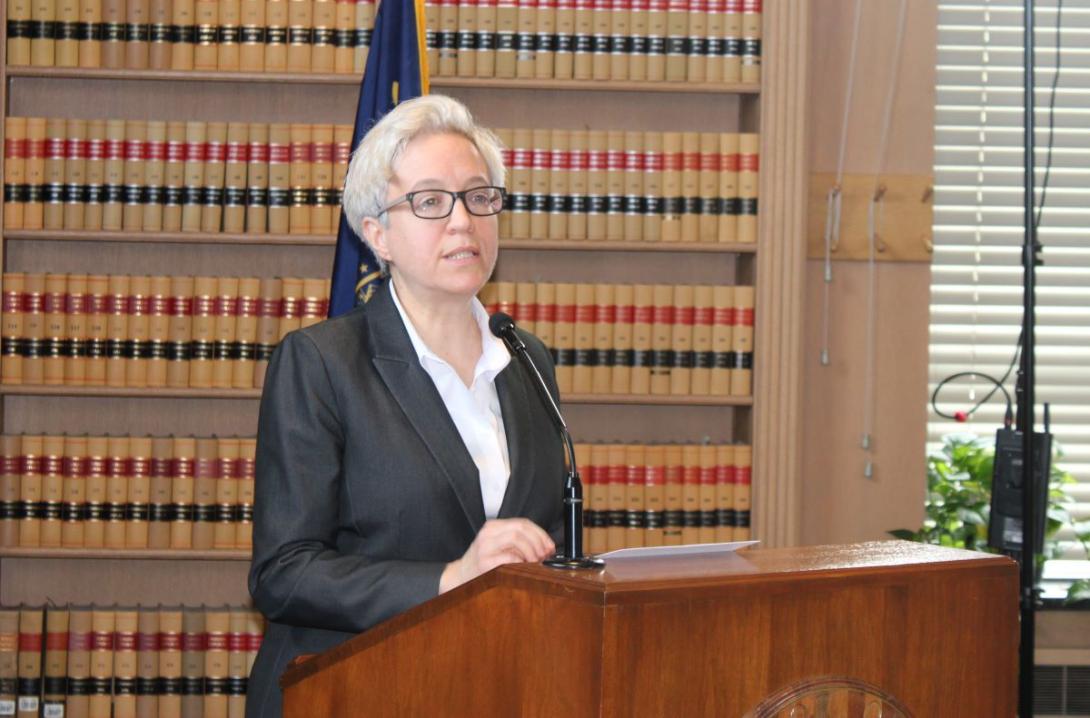
This story has been updated with comment from Gov. Tina Kotek's office.
Oregon lawmakers on Wednesday received their first briefing on Gov. Tina Kotek’s initiative to fix the state’s fractured and underdeveloped behavioral health system. But some observers said the update raised as many questions as it answered.
Last August, Kotek hired Juliana Wallace to direct her Behavioral Health Initiative, a plan that had not yet been developed. Eight months later, speaking to the Senate Health Care Committee, Wallace described a three-part plan to build on recent efforts to add treatment beds and bolster the state’s behavioral health workforce, as well as implement HB 4002 — the Measure 110 partial repeal and revision passed by lawmakers earlier this year.
But the presentation was sparse on details, leaving some people with questions and a key lawmaker with the hope of learning more.
“I would really like to hear the next steps as soon as possible,” State Sen. Deb Patterson, D-Salem, told The Lund Report after the hearing. Patterson added that she appreciated Wallace answering the committee’s questions and explaining the governor’s plans.
The briefing was significant because Kotek took office in January 2023 while promising to tackle the state’s behavioral health crisis. While she’s pressed lawmakers to increase funding, public records recently released indicate that as recently as four months ago high-level members of the governor’s staff were complaining about the lack of clarity around her behavioral health initiative intended to address the crisis.
Oregon has some of the country’s highest rates of mental illness and substance use disorder while ranking among the worst states in terms of access to programs that could help.
Kotek spokesperson Elisabeth Shepard responded to questions from The Lund Report describing what Kotek has done to improve behavioral health since taking office. That includes directing the Oregon Health Authority to assess the state's "need for mental health, substance use and recovery services, treatments and supports and a regional approach to meeting that need."
Other efforts highlighted by Shepard include Kotek reaching an agreement with the state's coordinated care organizations, regional Medicaid insurers, to spend $25 million on behavioral health staffing and facilities. Additionally, Kotek has worked with elected leaders in Multnomah County on the fentanyl crisis and helped secure a new 70-bed behavioral health treatment center in Portland.
"The Governor’s behavioral health priorities will be embedded with clear implementation goals, including metric outcomes," Shepard said.
These goals will be a close part of Kotek's budget development and will be finalized by the end of the current two-year budget cycle that ends summer of next year.
Shepard said that there is broad agreement that "Oregon’s behavioral health crisis didn’t happen overnight and will take deliberate strategies and investments to stabilize."
“If we’re not doing something to curb that demand, then we’ll never catch up."
Weighty goals, not much detail
The roughly 12 minute-long presentation Wallace delivered to lawmakers was light on numbers, specific next steps or outcomes to expect. The presentation quoted Kotek’s earlier statements that Oregonians should be able to get services regardless of where they live or what they can afford.
Wallace said when it comes to the initiative’s focus on staffing shortages in the behavioral health system, it would build on “the successes and learnings” from earlier loan repayment programs, scholarships and stipends to attract staff to rural areas.
The goal is to build on the 30% rate increase approved for providers serving large proportions of Oregon Health Plan members, as well as behavioral health workforce funding lawmakers approved in 2022, she said.
Wallace said there should be “entry points at every step of the way” for someone who wants to enter the behavioral health workforce. She said that should extend to someone just getting an associate’s degree to someone who wants to gain more education.
Another initiative is improving “customer service” for social workers and mental health workers seeking to obtain or keep their license. The state board that licenses social workers has previously faced complaints of delays in licensing times.
Wallace said she and other staff are planning for increases in additional treatment beds, which she said will include recovery housing, youth behavioral health services, substance use residential services and withdrawal management. She added that the beds would be a mix of long-term and short-term care.
Wallace said Kotek’s initiative will balance the immediate and long-term needs of each of the state’s regions.
She also showed lawmakers an illustration based on a roundtable of experts and government employees in September 2023 that envisioned an improved system. It noted “there is no unified strategy to align and coordinate existing efforts, which are disparate and siloed.”
Not much was said at the hearing about how to achieve that.
Reactions mixed
After the hearing, Chris Bouneff, the Oregon executive director of the National Alliance on Mental Illness, told The Lund Report it made sense that Wallace’s presentation would be general because Kotek is still putting together a budget and policies to submit to the Legislature when it reconvenes next year.
Bouneff also noted improving the behavioral health services will take time after 20 years of underinvestment.
“We’re just going to keep hitting these boundaries,” he said. “That’s just basic economics.”
He said the state’s workforce challenge is about more than just training professionals. People being served by Oregon Health Plan often have more complex needs that require care from people with more experience, but they often leave for better paying jobs in private practice, he said. The question, he said, is how does Oregon keep those professionals “in the public system for at least some period of time?”
A “glaring omission” from the update, he said, is how to improve the state’s inadequate mental health services for youth and address problems before they grow — creating greater needs later on.
“If we’re not doing something to curb that demand, then we’ll never catch up,” he said.
In the hearing, state Sen. Cedric Hayden, a Fall Creek Republican and the committee’s vice-chair, noted the state’s “lack of success” in improving mental and behavioral health. Afterward, he told The Lund Report that the update felt like “window dressing.”
Hayden questioned Kotek’s office’s “ability to move forward” after the departure of three of Kotek’s top aides over what records indicate was a dispute over First Lady Aimee Kotek Wilson’s involvement in the office.
“We don’t know if they are improving the quality of life for the people affected by them. We’re just throwing money at the problem, and that’s where the governor is now.”
Two other activists who did not watch the hearing said more needs to be done.
Jason Renaud, of the Mental Health Association of Portland, told The Lund Report that more spending is needed, but based on the existing sources of state funding, “The chances of fixing the system are virtually zero ... we’ve been starving the system for a long time.”
An analysis released earlier this year concluded the state would need to spend $500 million over at least five years to create the 3,000 behavioral health beds needed across the state to meet demands. A more recent analysis found the state needs to spend $6.85 billion to have adequate services for substance use disorders.
In addition to spending, Renaud said the state should do more to ensure the programs it funds are properly staffed, designed, and are measurably effective.
“We don’t know if they are improving the quality of life for the people affected by them,” he said, adding without that information, “We’re just throwing money at the problem, and that’s where the governor is now.”
He said the problems Oregon faces are national in scope. Care needs to be patient-centered, and “that’s not happening …It’s quality, not just quantity. They need to look at quality as well.”
Kevin Fitts, executive director of the Oregon Mental Health Consumers Association, told The Lund Report that getting a treatment bed requires someone to show up and keep checking back in, when there should be a central list of open beds.
Fitts, who is also a volunteer member of The Lund Report’s Community Advisory Board, said “These things are little details that the top folks never seem to address.”
You can reach Jake Thomas at [email protected] or via Twitter @jthomasreports
Comments
Bottom line: There are NOT…
Bottom line: There are NOT enough behavioral health providers. We can't build them in 6 months like a building....we need more students participating in these programs and funding to help them get through.

Hopefully, the State will move away from paying the lesser of Medicare/Medicaid for MH LPC's that became an accepted provider type under Medicare. Under Medicaid the payment for a 1 hour Individual Therapy visit would be $178.59. If the person has Medicare primary the payment goes down to $112.96 ($150.52 Full Medicare Rate x .75 LPC Rate).